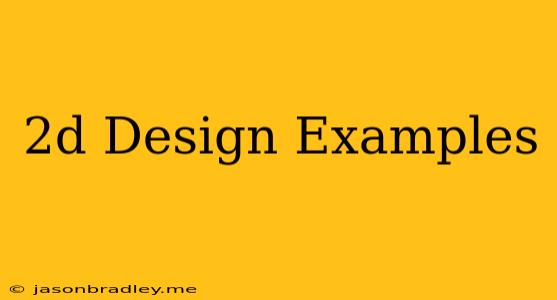2D Design Examples: Exploring the World of Flat Design
2D design is a fundamental aspect of visual communication, encompassing a wide array of applications and styles. From the humble logo to intricate illustrations, 2D design plays a crucial role in shaping how we perceive and interact with the world around us.
Here are some examples of 2D design:
1. Graphic Design
- Logos: A strong and memorable logo is the cornerstone of any brand identity. Think of iconic logos like Apple's apple, Nike's swoosh, or Coca-Cola's script. These designs are simple, yet instantly recognizable, effectively communicating the essence of the brand.
- Brochures and Flyers: These printed materials are designed to inform and engage audiences. They often incorporate compelling typography, imagery, and color schemes to convey messages effectively.
- Posters: Posters are a powerful tool for advertising and communicating ideas. From movie posters to political campaigns, they use bold visuals and impactful typography to grab attention and convey a message.
- Website Design: 2D design principles are essential for creating visually appealing and user-friendly websites. Layout, typography, color palettes, and imagery all contribute to a cohesive and engaging online experience.
- Social Media Graphics: From engaging social media posts to eye-catching banner ads, 2D design plays a significant role in creating content that stands out and captures attention on social media platforms.
2. Illustration
- Character Design: Illustrators bring characters to life with their unique style and skill. Whether it's for animated films, comics, or video games, character design involves creating compelling and memorable visual representations.
- Editorial Illustrations: Illustrations are used in newspapers, magazines, and books to enhance storytelling and communicate complex ideas visually.
- Concept Art: Artists create visual concepts for films, video games, and other projects, setting the tone and visual direction for the final product.
3. Typography
- Fonts and Typefaces: Typography is the art of arranging letters and words to create visually appealing and readable text. Fonts and typefaces play a vital role in conveying the tone and mood of a design, making it essential for graphic design, branding, and website design.
- Layout and Spacing: The way text is arranged on a page is crucial for readability and visual appeal. Typography involves understanding spacing, alignment, and hierarchy to create effective layouts.
4. Photography
- Photo Editing: Digital image editing is a fundamental aspect of 2D design. Designers manipulate photographs using software like Photoshop to enhance images, create special effects, and achieve desired visual outcomes.
- Photo Collage: Collage is a technique where multiple images are combined to create a single, cohesive image.
Conclusion
2D design is a diverse and dynamic field with limitless possibilities. Understanding the fundamental principles and exploring different examples can unlock your creativity and inspire you to create impactful and engaging visual designs.
